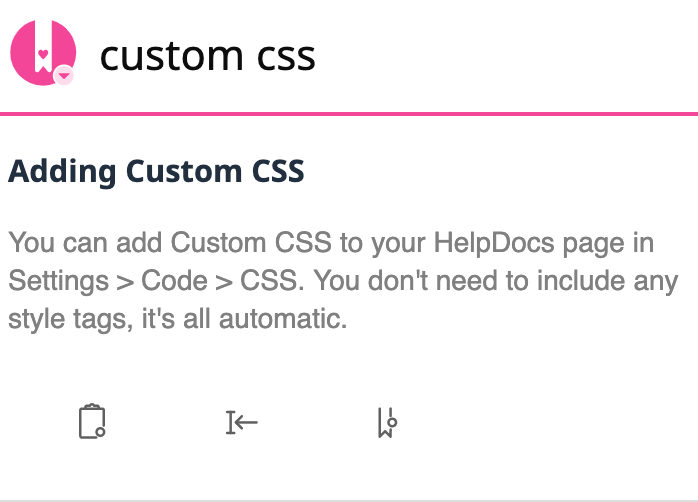
As you probably know by now you can't avoid every ticket. As much as us customer support people try to get everything documented it's a seemingly impossible task. But just because the customer didn't get the answer from your knowledge base in the first place doesn't mean you can't still leverage and promote it.
We use our knowledge base in almost every reply we send to our customers. In fact, it's pretty strange how much we rely on sending over links to help add context.
By making use of what we have we've been able to cut down response times and email length. It has also helped us scale our support beyond what we thought was possible.
More than that it's helped our customers understand a product that's not always clear and helped us build a product that's getting clearer by the day.
So here's a brief article about how we do it. From contextual links to pointing hands—we usually manage to get in a link or two 😏
Having your articles there when you need them
Here's the scenario we used to go through. We'd want to send a link over to a customer. We'd head to our knowledge base, search for the right article, copy the link, and then after all that paste it. Then usually go back to the browser and check it was useful.
It was a momental effort every time we did it. And so we didn't do it very often after that. Not only would it affect our search stats data but it'd take at least a few minutes. Wouldn't you rather boil the kettle? 🚂
That's exactly why we built our Chrome and Front integrations. Having the ability to search for articles alongside our ticketing system, copy the links, and paste them alongside our responses makes the process so much easier. It's a real time saver—honestly.
"So whatever platform you're using make sure you can access your articles without spending time tracking them down."
I totally understand you might not be using HelpDocs though. We're not for everyone. But whatever platform you use for your customer support there's a way to make more use of your knowledge base. And spend less time clicking and copying.
Most knowledge base platforms that are integrated with a ticketing system have some sort of quick linker. Use that thing! Go wild and paste 1, 2, or even 3 links. Point your customers to your knowledge base so they know it exists.
But let's say yours doesn't have a quick linker. Here's a few retrofittable ideas to make it work:
- Use keyboard shortcuts. You'd only wanna set up keyboard shortcuts if you needed these links super often. Otherwise you could be pasting links without even noticing. There's usually a text expander app included in your OS you can use to make htmltemps turn into https://support.helpdocs.io/article/l8q1fmsnx7-getting-started-with-a-custom-html-template💖
- Keep a swipe file. Use your go-to notes app and keep a list of the knowledge base articles you tend to share. For us we'd probably include our article about custom CSS article since we link to it a lot.
If you make it easy for yourself in the future it'll be worth the time spent now. You'll thank your past self.
Using contextual links in customer support tickets
Having the links available is one thing but how do we use them? When does it make sense for us to include them? How can we encourage customers to check out our knowledge base?
Here's a scenario we see often. One of our customers wants to make some customizations to their knowledge base. There's a few things we have shouldn't assume before replying:
- Their skill level. We can't assume they are or aren't a developer or do or don't have experience with code. Doing so could be insulting or patronizing and we don't want that.
- If they know about the feature. They might've signed up to HelpDocs not knowing if we even support custom CSS. Rather than blatantly saying "the custom CSS" we have to offer education and context.
- If they know where the feature lives. So they might know how to code. And they might know that it's a feature. But do they know where it is in the app? Even if they'd used it before we can't assume they remember.
All of these reasons are good cases to include a contextual link to our knowledge base article about custom CSS. We want to include a link to read more without making them feel silly for asking.

By extracting the location of the feature they also don't have to read the article if they don't want to learn more. It's totally up to them which can only be a good thing.
Hey Alex! 👋 You sure can! You'll probably wanna add some custom CSS by heading to Settings > Code > CSS.
The great thing about contextual knowledge base links is that we can include them wherever we have an article that covers that specific feature or topic. Adding a link doesn't distract from the main email so go wild and get linking!
Directing customers to a specific knowledge base article
Sometimes we get a question that comes through and it's answered directly in a knowledge base article. Or maybe it's the perfect article for them but they just don't know it.
For these we use the ol' pointing finger (👉). The pointing finger kinda replaces the boring colon and it points to an article's title with the link attached.
More on that over here 👉 Adding Custom CSS
Unlike contextual links we are directly encouraging the customer to click on this knowledge base article to help provide more information based on their question. This means:
- The customer gets more information in a digestible format. Emails are good and all but with a knowledge base article you can include GIFs, video, and step-by-step instructions.
- Our team doesn't have to rewrite help content. As much as we love helping customers out we don't want to re-write knowledge base articles inside an email. This encourages us to update and focus on knowledge base content rather than canned responses.
We also link to different sections inside our articles so they only get relevant and useful content. Less scrolling is always a winner 🎉
Using support tickets to improve our knowledge base
It's a two way street when it comes to our knowledge base and support tickets. By thinking about which articles we can link to we're always coming up with new topics we can document or ways to improve what we already have.
"By listening to our customers and the words they use to describe our own product we're able to help them out in a clear, concise way."
Here's some questions we often ask ourselves:
- What could we have done to help this appear in search? While we do our best to add useful tags we don't always use the same words as our customers. If it's a hyper-relevant article we tend to add a tag based on the support ticket language.
- Is there something we could add it make this more clear? I'd love to say all our articles were 100% clear. But then I'd have a super long nose. We try our best to polish wording and readability by previewing articles we're sending.
- Should we create a new article or section for this? As we grow we're hearing more and more use cases from our customers. Things we'd never even considered crop up. If we create an article or section for it we can help more customers work out how to do it themselves.
A knowledge base is an ever-changing document. By listening to our customers and the words they use to describe our own product we're able to help them out in a clear, concise way.
Keeping our knowledge base front of mind
Everything we do is centered around our knowledge base—after all we do make knowledge base software. But it's not just about saving time by reducing support load. It's about providing the most useful information for each customer. And I think that's something we can all be better at.
Each customer is different and we try our best not to assume skill level. By sending everyone to the same articles we get useful feedback from customers of all levels. Sometimes an article is too complicated and needs simplifying. Sometimes it's too simple and needs a few more sections. And sometimes it's just plain outdated.
By keeping our knowledge base and support tickets linked so heavily we can offer helpful, timely support that doesn't take an hour per ticket. Your customers and support team will thank you for that.